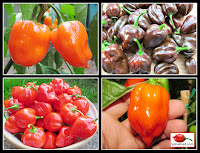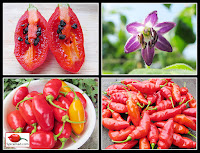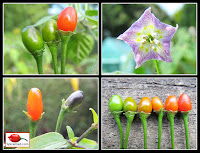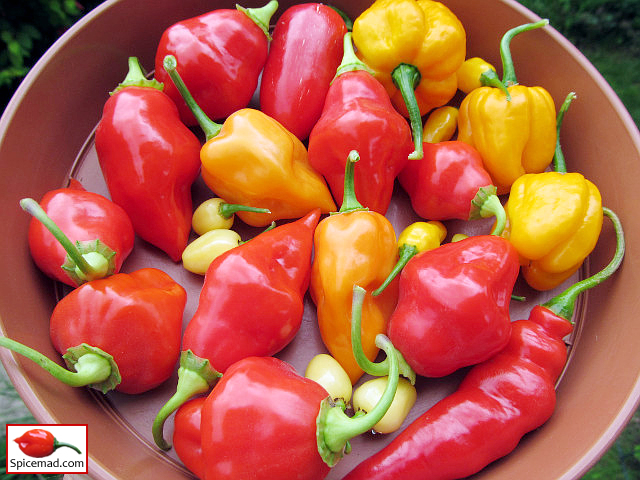Capsicum Species
All Capsicum species are native to the tropical regions of the Americas and are members of the Solanaceae family, which also includes plants such as potato, tomato, tobacco and aubergine (egg plant). Given how chilli peppers originate from the Amazon Basin in South America, and that millions of people around the world now consume them on a daily basis, it's certainly safe to say that they've travelled a long way!
Chilli peppers have an interesting history and have been used for thousands of years by the indigenous people of the Americas. By studying starch grains found on pottery shards collected from two sites in Southwestern Ecuador, experts were able to trace the domestication of chilli peppers back to at least 6,100 years ago. Given the understanding that no chilli peppers were ever domesticated in Ecuador, the scientists who made the discovery believe that they must have been domesticated elsewhere at an earlier date and then moved into the area.
The ancient Maya people of Mesoamerica consumed chilli peppers on a daily basis with food, and even added them to sacred chocolate drinks, along with other local ingredients, such as honey and vanilla. Archaeological remains recovered from caves in Northwestern Mexico and Eastern-Central Mexico suggests that native Mexican tribes were harvesting and consuming chillies as far back as 9,000 years ago. Ancient Peruvian cultures also held chilli peppers in high regard and traces of them have been found in the Guitarrero Cave in Peru, and dated to around 6,000 BC. The general consensus is that chillies were introduced into the Old World by Christopher Columbus when he returned from his second voyage to the Americas in 1496. However, some evidence exists which may suggest that chilli peppers already had a presence in the Old World prior to that time.
Capsicum is a genus of plants from the Solanaceae family (nightshade family). The name may either derive from the Greek word 'kapto', meaning to gulp, presumably alluding to the spicy nature of the fruit, or from the Latin word 'capsa', meaning 'box', which may either be alluding to the shape of the fruit or its hollow nature. All plants are grouped within an order — family, genus and species. Chillies and peppers belong to the Solanaceae family (nightshade family) and to the genus Capsicum. Within the Capsicum genus there are many species, but only five of them are domesticated. Information about each of the five domesticated Capsicum species can be found below.
In some countries, the name 'Capsicum' is also used to refer to heat-free peppers (sweet peppers), particularly Bell Peppers. However, in said countries all spicy peppers are still usually referred to as chillies, chilli peppers or hot peppers. When referring to chillies, the name 'pepper' came into use because plants belonging to the Capsicum genus typically produce piquant fruit which can be likened to the piquant nature of black pepper. However, there is no botanical relationship between Capsicum and black pepper (Piper nigrum).
Chillies, also spelt 'chilies' (in American English) and 'chiles' (in Spanish-speaking countries), are the piquant fruits of the Capsicum genus and one of the oldest cultivated crops in the Americas. Archaeological evidence suggests they were consumed as far back as 7,500 BC. Chillies come in many shapes, colours and sizes, and can range in pungency from 0 to over 2,000,000 Scoville Heat Units (SHU). The Scoville scale is a measurement used to determine the level of capsaicin in chillies, the chemical which makes them hot, and is named after its creator, American pharmacist Wilbur Scoville (1865–1942). There are approximately 35 Capsicum species known to date, but only five of these are domesticated — C. annuum, C. baccatum, C. chinense, C. frutescens and C. pubescens. Known affectionately by some as the 'famous five', the thousands of domesticated chilli pepper varieties grown in gardens and greenhouses throughout the world today are all members of one of the five aforementioned species.
Capsicum annuum is the most widely cultivated species in the world and is the one that most people will be familiar with in the West. The name 'annuum' means 'annual', but all chilli plants, regardless of the species, are perennial and can live for many years in frost-free regions. However, in temperate climates they are normally grown as annuals because they will not survive the low winter temperatures.
With fruit sizes and shapes varying from that of the small, berry-like Chiltepins to that of the large, thick-walled, juicy Bell Peppers, Capsicum annuum is the most widely distributed Capsicum species in the world and is home to some of our most beloved chilli varieties, such as the much-loved Jalapeño. The flowers are typically white, but some varieties, such as Maui Purple, Bolivian Rainbow, Hungarian Black, Peruvian Purple, Pretty In Purple, Purple Cayenne, Black Scorpion Tongue, Buena Mulata, Purple UFO, Filius Blue and Black Pearl, have purple or variegated purple and white flowers.
The ancestor of the domesticated form is said to be the Chiltepin (C. annuum var. glabriusculum), a wild variety of Capsicum annuum native to southern North America, Central America and northern South America that produces small, spherical-shaped pea-sized chillies. Some well known pod types belonging to the domesticated form of this species include: Jalapeño, Cayenne, Serrano, Bell, Cherry and Wax. The chillies come in many shapes, colours and sizes, and range in pungency from 0 to about 100,000 Scoville Heat Units (SHU).
Family: Solanaceae | Genus: Capsicum | Species: annuum | Pronunciation: ANN-you-um
Capsicum baccatum was a favourite of the Inca and is said to have been domesticated in Peru and Bolivia approximately 2,500 years ago. It is the most widely grown species in South America (Brazil, Bolivia, Chile, Colombia, Peru and Ecuador), and the names of many Capsicum baccatum varieties are often prefixed with the word 'Aji', which comes from the Oto-Manguean languages of the Americas and means 'chilli'.
The name 'baccatum' means 'berry-like', and is presumably an allusion to the small berry-like fruits belonging to the wild form (C. baccatum var. baccatum). This species can withstand fairly low temperatures, but not frost, and the plants are always very prolific and typically have an open or spreading growth habit. One characteristic of this species is the green, brown or golden coloured markings on the flower corollas. Chillies belonging to this species are not widely sold outside of their native South America and can be some of the hardest to source in the West. A very popular variety belonging to this species is Aji Amarillo, which is an orange coloured variety that's widely used in Peruvian and Bolivian cuisines. The name 'Aji Amarillo' means 'yellow chilli' in Spanish.
Although the names of many varieties belonging to the C. baccatum species are often prefixed with the word 'Aji', it doesn't always mean that if a variety contains the word Aji in its name that it automatically belongs to this species. There are some varieties belonging to the other four domesticated Capsicum species that also contain the word Aji in their names, such as Aji Cereza and Aji de Jardin (C. annuum), Aji Mochero and Aji Arnaucho (C. chinense), Aji Guaguao (C. frutescens) and Aji Largo (C. pubescens). There are also some C. baccatum varieties that don't contain the word Aji in their names, such as El Oro de Ecuador, Inca Berry, Brazilian Pumpkin, Inca Red Drop, Queen Laury, Criolla Sella, Guampinha de Veado and Nepalese Bell.
The chillies come in many shapes, colours and sizes, and the pod shapes of the domesticated form (C. baccatum var. pendulum) are probably the most diverse of all the Capsicum species. Some well known Capsicum baccatum varieties include: Aji Amarillo and Aji Lemon (both from Peru), Aji Crystal (from Chile), Bishop's Crown (from Barbados) and Brazilian Starfish and Dedo de Moça (both from Brazil). The pungency can range from 0 to about 75,000 Scoville Heat Units (SHU).
Family: Solanaceae | Genus: Capsicum | Species: baccatum | Pronunciation: bah-COT-tum
Capsicum chinense contains a broad range of varieties and is the most widely grown species in the Caribbean. All of the world's hottest chillies are members of this species, but perhaps the two most famous types in the West are Habanero and Scotch Bonnet. Capsicum chinense varieties are synonymous with Caribbean and Yucatecan cuisines and are easily recognised because of their tropical fruity aroma and citrus-like flavour.
The name 'chinense' means 'from China', although this is misleading. Dutch botanist Nikolaus Joseph Von Jacquin erroneously named the species in 1776, believing it to have originated in China. The species originated in the Amazon Basin over 8,000 years ago and eventually spread outwards to the Yucatán Peninsula and the Caribbean, most likely by migrating birds or migrating tribes from the South American mainland. An intact fruit of a small domesticated Habanero was found in the Guitarrero Cave in Peru, and was dated to 6,500 BC.
Capsicum chinense is a tropical species and the seeds of some varieties can take up to three weeks to germinate. The plants require warmer temperatures, higher humidity levels and a longer growing season than those belonging to the C. annuum, C. baccatum and C. frutescens species. Although C. pubescens varieties can tolerate low temperatures, they too typically require a longer growing season than the three aforementioned species. Capsicum chinense is often synonymous with searing heat levels and gnarly-looking fruits, but some varieties, such as Trinidad Perfume and Trinidad Seasoning, are almost heat-free and are widely used as seasoning peppers throughout the Caribbean.
Some well known Capsicum chinense varieties include: Orange Habanero and Caribbean Red Habanero (both from Mexico), Antillais Caribbean (from the Netherlands Antilles), Fatalii (from Central Africa), Aji Limo and Aji Charapita (both from Peru), Naga Morich and Bhut Jolokia (both from Northeast India and Bangladesh), Moruga Scorpion and 7-Pot (both from Trinidad and Tobago) and Chocolate Habanero (from the Caribbean). The pungency can range from 0 to over 2,000,000 Scoville Heat Units (SHU).
Family: Solanaceae | Genus: Capsicum | Species: chinense | Pronunciation: chi-NEN-see
Capsicum frutescens is one of the lesser-known domesticated Capsicum species and contains fewer fruit shapes, colours and sizes than C. annuum, C. baccatum and C. chinense, and this is believed to be due to a lack of human selection. The name 'frutescens' means 'bushy' or 'shrub-like', and plants belonging to this species typically have a bushy growth habit and grow between one and four feet in height.
The C. frutescens species is believed to have originated in either Central or South America, where it still grows wild today. In recent times, it has been bred to produce ornamental chilli pepper strains because of its prolific nature. Two characteristics of this species are the light green or yellow coloured tint on the flower corollas, and when fully ripe the fruit comes away from the calyx very easily (deciduous), a trait shared by all wild Capsicum species. This genetic trait makes the fruit a quick and safe meal for birds, which are the primary dispersal vectors for chilli pepper seeds in the wild. Chillies belonging to the Capsicum frutescens species play an important role in African cuisines, especially Ethiopian cuisine, and the species was likely introduced into Africa by the Portuguese via their 16th century trading routes.
Some well known Capsicum frutescens varieties include: Malagueta (from Brazil), Siling Labuyo (from the Philippines), Aji Criollo and Aji Guaguao (both from Cuba), Bradley's Bahamian (from the Bahamas) and Madre de Rios (from the Amazon rainforest). However, perhaps the most well known variety of all is Tabasco, which is used by the McIlhenny Company of Avery Island, Southern Louisiana, to make the famous Tabasco® Original Red Pepper Sauce. Capsicum frutescens varieties tend to be quite hot and can range from 60,000 to about 150,000 Scoville Heat Units (SHU).
Family: Solanaceae | Genus: Capsicum | Species: frutescens | Pronunciation: fru-TES-enz
Capsicum pubescens dates back to pre-Incan times and was first domesticated in the Andean region of Peru and Bolivia around 6,000 BC, making it one of the first domesticated plants in the Americas. The existence of C. pubescens was documented by ancient Peruvian cultures, and traces of it have been found in the Guitarrero Cave, which is an important archaeological site located in the Ancash region of Peru.
The name 'pubescens' means 'hairy' or 'fuzzy', and is a reference to the soft downy hairs that cover the leaves and sometimes the stems. There is no wild form of Capsicum pubescens, but it is closely related to two wild species which are native to the Andes Mountains and will readily cross pollinate with them both, which is something it won't do with any of the other four domesticated Capsicum species. As with C. baccatum, the species can withstand fairly low temperatures, and two characteristics that set it apart are the blue-violet coloured flowers and black seeds.
Once a favourite of the Inca and the cultures preceding them, peppers belonging to this species are thick-walled and juicy and can vary in shape, size, colour and pungency. However, as with C. frutescens, Capsicum pubescens contains fewer fruit shapes, colours and sizes than C. annuum, C. baccatum and C. chinense. Chilli peppers belonging to the Capsicum pubescens species are known by different names, such as Rocoto, Locoto and Manzano, and the pungency can range from 15,000 to about 100,000 Scoville Heat Units (SHU).
Family: Solanaceae | Genus: Capsicum | Species: pubescens | Pronunciation: pew-BES-enz
Occurring naturally from Argentina to the Southern United States, there are approximately 30 verified wild Capsicum species known to date. It's possible that more species may be growing deep within the Amazon rainforest and have still yet to be discovered. However, sadly it's also very possible that some of the undiscovered species may have already gone extinct due to agricultural practices and deforestation.
There are too many wild Capsicum species to list here, but some of the well known ones include: C. galapagoense (endemic to the Galápagos Islands), C. praetermissum (native to Brazil and Paraguay), C. chacoense (native to the Gran Chaco), C. eximium (native to the Andes Mountains), C. flexuosum (native to Brazil and Paraguay), C. lanceolatum (native to Guatemala, Honduras and Mexico), C. rhomboideum (native to Mexico, Central America and the Andes Mountains) and C. tovarii (native to Peru and named after the late Peruvian botanist Oscar Tovar-Serpa (1923–2009), who discovered the plant in April 1954 on the slopes of the Rio Mantaro basin in the departments of Huancavelica and Ayacucho in the Peruvian Andes).
Although the aforementioned wild Capsicum species may be well known to chilli-heads, several of them are very rare and the seeds can be hard to obtain. If you'd like to research wild Capsicum species then two websites that I highly recommend visiting are infernochili.net and pepperfriends.org, both of which are not written in English and may therefore need to be translated.
Chilli peppers have an interesting history and have been used for thousands of years by the indigenous people of the Americas. By studying starch grains found on pottery shards collected from two sites in Southwestern Ecuador, experts were able to trace the domestication of chilli peppers back to at least 6,100 years ago. Given the understanding that no chilli peppers were ever domesticated in Ecuador, the scientists who made the discovery believe that they must have been domesticated elsewhere at an earlier date and then moved into the area.
The ancient Maya people of Mesoamerica consumed chilli peppers on a daily basis with food, and even added them to sacred chocolate drinks, along with other local ingredients, such as honey and vanilla. Archaeological remains recovered from caves in Northwestern Mexico and Eastern-Central Mexico suggests that native Mexican tribes were harvesting and consuming chillies as far back as 9,000 years ago. Ancient Peruvian cultures also held chilli peppers in high regard and traces of them have been found in the Guitarrero Cave in Peru, and dated to around 6,000 BC. The general consensus is that chillies were introduced into the Old World by Christopher Columbus when he returned from his second voyage to the Americas in 1496. However, some evidence exists which may suggest that chilli peppers already had a presence in the Old World prior to that time.
What Does Capsicum Mean?
Capsicum is a genus of plants from the Solanaceae family (nightshade family). The name may either derive from the Greek word 'kapto', meaning to gulp, presumably alluding to the spicy nature of the fruit, or from the Latin word 'capsa', meaning 'box', which may either be alluding to the shape of the fruit or its hollow nature. All plants are grouped within an order — family, genus and species. Chillies and peppers belong to the Solanaceae family (nightshade family) and to the genus Capsicum. Within the Capsicum genus there are many species, but only five of them are domesticated. Information about each of the five domesticated Capsicum species can be found below.
In some countries, the name 'Capsicum' is also used to refer to heat-free peppers (sweet peppers), particularly Bell Peppers. However, in said countries all spicy peppers are still usually referred to as chillies, chilli peppers or hot peppers. When referring to chillies, the name 'pepper' came into use because plants belonging to the Capsicum genus typically produce piquant fruit which can be likened to the piquant nature of black pepper. However, there is no botanical relationship between Capsicum and black pepper (Piper nigrum).
What Are Chillies?
Chillies, also spelt 'chilies' (in American English) and 'chiles' (in Spanish-speaking countries), are the piquant fruits of the Capsicum genus and one of the oldest cultivated crops in the Americas. Archaeological evidence suggests they were consumed as far back as 7,500 BC. Chillies come in many shapes, colours and sizes, and can range in pungency from 0 to over 2,000,000 Scoville Heat Units (SHU). The Scoville scale is a measurement used to determine the level of capsaicin in chillies, the chemical which makes them hot, and is named after its creator, American pharmacist Wilbur Scoville (1865–1942). There are approximately 35 Capsicum species known to date, but only five of these are domesticated — C. annuum, C. baccatum, C. chinense, C. frutescens and C. pubescens. Known affectionately by some as the 'famous five', the thousands of domesticated chilli pepper varieties grown in gardens and greenhouses throughout the world today are all members of one of the five aforementioned species.
Capsicum annuum
Capsicum annuum is the most widely cultivated species in the world and is the one that most people will be familiar with in the West. The name 'annuum' means 'annual', but all chilli plants, regardless of the species, are perennial and can live for many years in frost-free regions. However, in temperate climates they are normally grown as annuals because they will not survive the low winter temperatures.
With fruit sizes and shapes varying from that of the small, berry-like Chiltepins to that of the large, thick-walled, juicy Bell Peppers, Capsicum annuum is the most widely distributed Capsicum species in the world and is home to some of our most beloved chilli varieties, such as the much-loved Jalapeño. The flowers are typically white, but some varieties, such as Maui Purple, Bolivian Rainbow, Hungarian Black, Peruvian Purple, Pretty In Purple, Purple Cayenne, Black Scorpion Tongue, Buena Mulata, Purple UFO, Filius Blue and Black Pearl, have purple or variegated purple and white flowers.
The ancestor of the domesticated form is said to be the Chiltepin (C. annuum var. glabriusculum), a wild variety of Capsicum annuum native to southern North America, Central America and northern South America that produces small, spherical-shaped pea-sized chillies. Some well known pod types belonging to the domesticated form of this species include: Jalapeño, Cayenne, Serrano, Bell, Cherry and Wax. The chillies come in many shapes, colours and sizes, and range in pungency from 0 to about 100,000 Scoville Heat Units (SHU).
Family: Solanaceae | Genus: Capsicum | Species: annuum | Pronunciation: ANN-you-um
Capsicum baccatum
Capsicum baccatum was a favourite of the Inca and is said to have been domesticated in Peru and Bolivia approximately 2,500 years ago. It is the most widely grown species in South America (Brazil, Bolivia, Chile, Colombia, Peru and Ecuador), and the names of many Capsicum baccatum varieties are often prefixed with the word 'Aji', which comes from the Oto-Manguean languages of the Americas and means 'chilli'.
The name 'baccatum' means 'berry-like', and is presumably an allusion to the small berry-like fruits belonging to the wild form (C. baccatum var. baccatum). This species can withstand fairly low temperatures, but not frost, and the plants are always very prolific and typically have an open or spreading growth habit. One characteristic of this species is the green, brown or golden coloured markings on the flower corollas. Chillies belonging to this species are not widely sold outside of their native South America and can be some of the hardest to source in the West. A very popular variety belonging to this species is Aji Amarillo, which is an orange coloured variety that's widely used in Peruvian and Bolivian cuisines. The name 'Aji Amarillo' means 'yellow chilli' in Spanish.
Although the names of many varieties belonging to the C. baccatum species are often prefixed with the word 'Aji', it doesn't always mean that if a variety contains the word Aji in its name that it automatically belongs to this species. There are some varieties belonging to the other four domesticated Capsicum species that also contain the word Aji in their names, such as Aji Cereza and Aji de Jardin (C. annuum), Aji Mochero and Aji Arnaucho (C. chinense), Aji Guaguao (C. frutescens) and Aji Largo (C. pubescens). There are also some C. baccatum varieties that don't contain the word Aji in their names, such as El Oro de Ecuador, Inca Berry, Brazilian Pumpkin, Inca Red Drop, Queen Laury, Criolla Sella, Guampinha de Veado and Nepalese Bell.
The chillies come in many shapes, colours and sizes, and the pod shapes of the domesticated form (C. baccatum var. pendulum) are probably the most diverse of all the Capsicum species. Some well known Capsicum baccatum varieties include: Aji Amarillo and Aji Lemon (both from Peru), Aji Crystal (from Chile), Bishop's Crown (from Barbados) and Brazilian Starfish and Dedo de Moça (both from Brazil). The pungency can range from 0 to about 75,000 Scoville Heat Units (SHU).
Family: Solanaceae | Genus: Capsicum | Species: baccatum | Pronunciation: bah-COT-tum
Capsicum chinense
Capsicum chinense contains a broad range of varieties and is the most widely grown species in the Caribbean. All of the world's hottest chillies are members of this species, but perhaps the two most famous types in the West are Habanero and Scotch Bonnet. Capsicum chinense varieties are synonymous with Caribbean and Yucatecan cuisines and are easily recognised because of their tropical fruity aroma and citrus-like flavour.
The name 'chinense' means 'from China', although this is misleading. Dutch botanist Nikolaus Joseph Von Jacquin erroneously named the species in 1776, believing it to have originated in China. The species originated in the Amazon Basin over 8,000 years ago and eventually spread outwards to the Yucatán Peninsula and the Caribbean, most likely by migrating birds or migrating tribes from the South American mainland. An intact fruit of a small domesticated Habanero was found in the Guitarrero Cave in Peru, and was dated to 6,500 BC.
Capsicum chinense is a tropical species and the seeds of some varieties can take up to three weeks to germinate. The plants require warmer temperatures, higher humidity levels and a longer growing season than those belonging to the C. annuum, C. baccatum and C. frutescens species. Although C. pubescens varieties can tolerate low temperatures, they too typically require a longer growing season than the three aforementioned species. Capsicum chinense is often synonymous with searing heat levels and gnarly-looking fruits, but some varieties, such as Trinidad Perfume and Trinidad Seasoning, are almost heat-free and are widely used as seasoning peppers throughout the Caribbean.
Some well known Capsicum chinense varieties include: Orange Habanero and Caribbean Red Habanero (both from Mexico), Antillais Caribbean (from the Netherlands Antilles), Fatalii (from Central Africa), Aji Limo and Aji Charapita (both from Peru), Naga Morich and Bhut Jolokia (both from Northeast India and Bangladesh), Moruga Scorpion and 7-Pot (both from Trinidad and Tobago) and Chocolate Habanero (from the Caribbean). The pungency can range from 0 to over 2,000,000 Scoville Heat Units (SHU).
Family: Solanaceae | Genus: Capsicum | Species: chinense | Pronunciation: chi-NEN-see
Capsicum frutescens
Capsicum frutescens is one of the lesser-known domesticated Capsicum species and contains fewer fruit shapes, colours and sizes than C. annuum, C. baccatum and C. chinense, and this is believed to be due to a lack of human selection. The name 'frutescens' means 'bushy' or 'shrub-like', and plants belonging to this species typically have a bushy growth habit and grow between one and four feet in height.
The C. frutescens species is believed to have originated in either Central or South America, where it still grows wild today. In recent times, it has been bred to produce ornamental chilli pepper strains because of its prolific nature. Two characteristics of this species are the light green or yellow coloured tint on the flower corollas, and when fully ripe the fruit comes away from the calyx very easily (deciduous), a trait shared by all wild Capsicum species. This genetic trait makes the fruit a quick and safe meal for birds, which are the primary dispersal vectors for chilli pepper seeds in the wild. Chillies belonging to the Capsicum frutescens species play an important role in African cuisines, especially Ethiopian cuisine, and the species was likely introduced into Africa by the Portuguese via their 16th century trading routes.
Some well known Capsicum frutescens varieties include: Malagueta (from Brazil), Siling Labuyo (from the Philippines), Aji Criollo and Aji Guaguao (both from Cuba), Bradley's Bahamian (from the Bahamas) and Madre de Rios (from the Amazon rainforest). However, perhaps the most well known variety of all is Tabasco, which is used by the McIlhenny Company of Avery Island, Southern Louisiana, to make the famous Tabasco® Original Red Pepper Sauce. Capsicum frutescens varieties tend to be quite hot and can range from 60,000 to about 150,000 Scoville Heat Units (SHU).
Family: Solanaceae | Genus: Capsicum | Species: frutescens | Pronunciation: fru-TES-enz
Capsicum pubescens
Capsicum pubescens dates back to pre-Incan times and was first domesticated in the Andean region of Peru and Bolivia around 6,000 BC, making it one of the first domesticated plants in the Americas. The existence of C. pubescens was documented by ancient Peruvian cultures, and traces of it have been found in the Guitarrero Cave, which is an important archaeological site located in the Ancash region of Peru.
The name 'pubescens' means 'hairy' or 'fuzzy', and is a reference to the soft downy hairs that cover the leaves and sometimes the stems. There is no wild form of Capsicum pubescens, but it is closely related to two wild species which are native to the Andes Mountains and will readily cross pollinate with them both, which is something it won't do with any of the other four domesticated Capsicum species. As with C. baccatum, the species can withstand fairly low temperatures, and two characteristics that set it apart are the blue-violet coloured flowers and black seeds.
Once a favourite of the Inca and the cultures preceding them, peppers belonging to this species are thick-walled and juicy and can vary in shape, size, colour and pungency. However, as with C. frutescens, Capsicum pubescens contains fewer fruit shapes, colours and sizes than C. annuum, C. baccatum and C. chinense. Chilli peppers belonging to the Capsicum pubescens species are known by different names, such as Rocoto, Locoto and Manzano, and the pungency can range from 15,000 to about 100,000 Scoville Heat Units (SHU).
Family: Solanaceae | Genus: Capsicum | Species: pubescens | Pronunciation: pew-BES-enz
Wild Capsicum Species
Occurring naturally from Argentina to the Southern United States, there are approximately 30 verified wild Capsicum species known to date. It's possible that more species may be growing deep within the Amazon rainforest and have still yet to be discovered. However, sadly it's also very possible that some of the undiscovered species may have already gone extinct due to agricultural practices and deforestation.
There are too many wild Capsicum species to list here, but some of the well known ones include: C. galapagoense (endemic to the Galápagos Islands), C. praetermissum (native to Brazil and Paraguay), C. chacoense (native to the Gran Chaco), C. eximium (native to the Andes Mountains), C. flexuosum (native to Brazil and Paraguay), C. lanceolatum (native to Guatemala, Honduras and Mexico), C. rhomboideum (native to Mexico, Central America and the Andes Mountains) and C. tovarii (native to Peru and named after the late Peruvian botanist Oscar Tovar-Serpa (1923–2009), who discovered the plant in April 1954 on the slopes of the Rio Mantaro basin in the departments of Huancavelica and Ayacucho in the Peruvian Andes).
Although the aforementioned wild Capsicum species may be well known to chilli-heads, several of them are very rare and the seeds can be hard to obtain. If you'd like to research wild Capsicum species then two websites that I highly recommend visiting are infernochili.net and pepperfriends.org, both of which are not written in English and may therefore need to be translated.








